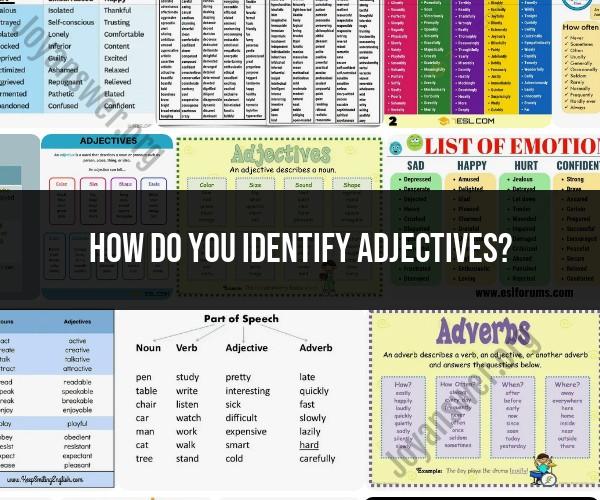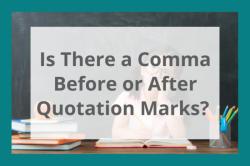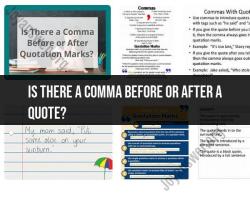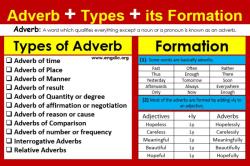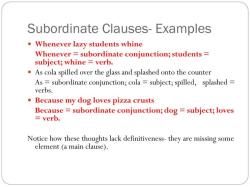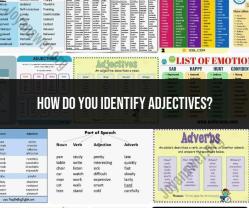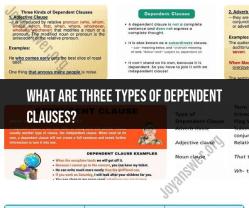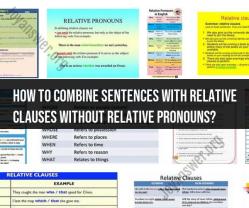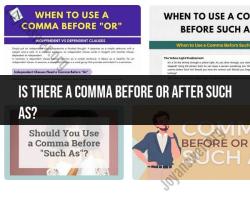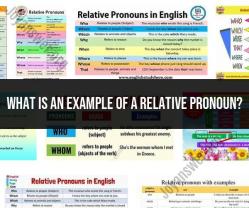How do you identify adjectives?
Adjectives are words used to modify or describe nouns or pronouns. They provide more information about the nouns or pronouns they are connected to. To identify adjectives in a sentence, you can follow these guidelines:
Word Function:
- Look for words in the sentence that describe or modify nouns or pronouns. Adjectives usually function to provide attributes, qualities, or characteristics of the noun they are modifying.
Ask "What Kind?" or "Which One?":
- Adjectives often answer questions like "What kind?" or "Which one?" For example, in the sentence "The red car is fast," "red" answers the question "What kind of car?" and "fast" describes the car.
Position in the Sentence:
Adjectives can appear in various positions in a sentence. They may come before the noun (attributive position), after a linking verb (predicate adjectives), or after a noun to provide additional information (appositive adjectives).
Attributive Adjectives: These adjectives directly precede the noun they modify. For example: "a beautiful flower," "the tall building."
Predicate Adjectives: These adjectives follow a linking verb (e.g., is, seems, appears) and describe the subject of the sentence. For example: "She is happy," "The day seems long."
Appositive Adjectives: These adjectives follow the noun and provide additional information about it. For example: "John, our tour guide, is knowledgeable."
Use of "and" or "or":
- Adjectives are often separated by the conjunctions "and" or "or" when multiple adjectives are used to describe a single noun. For example: "It's a big and beautiful garden."
Comparative and Superlative Forms:
- Some adjectives have comparative and superlative forms to indicate degrees of comparison. For example, "good" has the comparative "better" and the superlative "best."
Test with "A" or "An":
- Another way to identify adjectives is to see if they can be replaced with "a" or "an." If you can insert "a" or "an" before the word, it is likely an adjective. For example, "a green apple" or "an interesting book."
Check for Articles:
- Articles like "a," "an," and "the" are often used before nouns and can help identify the noun-adjective relationship. For example, "the red dress."
Context and Meaning:
- Sometimes, identifying adjectives may rely on the context and the meaning they convey in the sentence. Adjectives add descriptive information, so words that provide details about nouns and pronouns are often adjectives.
Remember that adjectives are a diverse group of words that can describe a wide range of qualities, including size, color, shape, age, emotions, opinions, and more. Practice and experience can help improve your ability to identify adjectives in sentences.
How to recognize and identify adjectives in sentences?
Adjectives are words that describe nouns. They can answer the questions "what kind," "how many," and "which one."
To identify adjectives in sentences, you can look for words that come before nouns and modify them. For example, in the sentence "The big red balloon floated in the air," the adjectives "big" and "red" describe the noun "balloon."
Adjectives can also come after nouns and modify them. For example, in the sentence "The balloon was big and red," the adjectives "big" and "red" still describe the noun "balloon."
What is the function of adjectives in language and communication?
Adjectives have several important functions in language and communication. They can:
- Make writing and speech more descriptive and vivid. For example, the sentence "The flowers were beautiful" is more descriptive than the sentence "The flowers were."
- Help readers and listeners to better understand the meaning of nouns. For example, the sentence "The big red balloon floated in the air" tells us more about the balloon than the sentence "The balloon floated in the air."
- Add emphasis and emotion to writing and speech. For example, the sentence "I am so happy to see you!" uses adjectives to express the speaker's strong emotions.
3. Tips for differentiating adjectives from other parts of speech
Here are some tips for differentiating adjectives from other parts of speech:
- Adjectives can modify nouns. For example, the adjective "big" modifies the noun "balloon" in the sentence "The big balloon floated in the air."
- Adjectives can answer the questions "what kind," "how many," and "which one." For example, the adjective "big" answers the question "what kind" in the sentence "The big balloon floated in the air."
- Adjectives can be compared using words like "more," "most," "less," and "least." For example, the adjective "big" can be compared in the following sentence: "The red balloon is bigger than the blue balloon."
4. How to use adjectives effectively to enhance writing and communication
Here are some tips for using adjectives effectively to enhance writing and communication:
- Use specific and vivid adjectives. Instead of saying "The house was big," you could say "The two-story Victorian house was imposing and elegant."
- Use adjectives to create a mood or atmosphere. For example, in the sentence "The dark and gloomy forest was filled with eerie noises," the adjectives "dark," "gloomy," and "eerie" create a sense of suspense and mystery.
- Avoid using too many adjectives. Overusing adjectives can make your writing sound cluttered and unprofessional.
5. The various types of adjectives and their roles in describing nouns
There are many different types of adjectives, but some of the most common include:
- Descriptive adjectives: These adjectives describe the physical appearance, qualities, or characteristics of nouns. For example, the adjectives "big," "red," and "beautiful" are descriptive adjectives.
- Numeral adjectives: These adjectives indicate quantity or number. For example, the adjectives "one," "two," and "many" are numeral adjectives.
- Demonstrative adjectives: These adjectives point out specific nouns. For example, the adjectives "this," "that," and "these" are demonstrative adjectives.
- Interrogative adjectives: These adjectives are used to ask questions. For example, the adjectives "what," "which," and "how many" are interrogative adjectives.
- Possessive adjectives: These adjectives show ownership or possession. For example, the adjectives "my," "your," and "their" are possessive adjectives.
- Proper adjectives: These adjectives are derived from proper nouns. For example, the adjectives "French," "American," and "American" are proper adjectives.
Adjectives play an important role in describing nouns. They can make our writing and speech more descriptive, vivid, and informative. By using adjectives effectively, we can communicate our ideas more clearly and persuasively.
